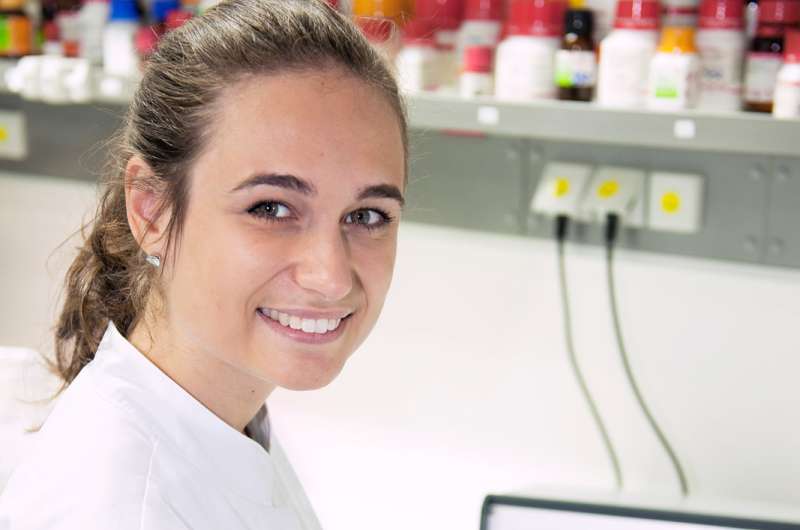Isabel Steppert, scientist at the Fraunhofer IZI, during Sample measurement. Credit: Fraunhofer IZI
Global air travel isn't restricted to people and goods – infectious agents, too, can make their way on board as unwelcome passengers and travel great distances within a matter of hours. In the air, the germs can spread unchecked. The HyFly joint research project aims to establish the scientific foundation for breaking chains of infection and, if possible, prevent pandemics. One way they hope to achieve this is by using a non-invasive method to identify infected individuals based on components in their breath.
Airports are hubs for pathogens from all over the world. Infectious diseases spread swiftly by air across countries and continents. According to the World Health Organization (WHO), the risk of global epidemics is increasing. New anti-infection strategies are needed. This is where the HyFly joint research project comes in, with 2.6 million in funding under the German Federal Ministry of Education and Research InfectControl 2020 initiative (see box "HyFly – project overview"). Partners from industry and research are developing strategies for disrupting the chains of infection in air transport and establishing effective countermeasures as a precaution. The project is expected to deliver concrete action plans for airport operators and airlines.
Using non-invasive diagnostics to detect infectious agents
One of the ways the project is attempting to control migration paths is by detecting infections quickly and efficiently as passengers undergo screening at airports, without using molecular biological methods. Researchers at the Fraunhofer Institute for Cell Therapy and Immunology IZI are establishing a non-invasive method for this purpose, based on ion mobility spectrometry (IMS).
"Molecular biological methods aren't suitable here, as they are too time-consuming. Instead, we will rely on IMS, a non-invasive method that doesn't require, for instance, any smears, or any blood or saliva samples. This method has proven successful in detecting drugs and explosive residues at airports around the globe for many years now," says Dr. Dirk Kuhlmeier, manager of the Working Group on MicroDiagnostics at Fraunhofer IZI. The researcher and his team are developing a system that will distinguish bacteria from one another in a matter of minutes based on volatile organic compounds (VOC), which are components of human breath. "IMS is notable for the possibility it offers to quickly and sensitively detect volatile organic compounds directly in the air," says Kuhlmeier.
Using gas chromatography, the breath components are first pre-separated and then transferred to the coupled ion mobility spectrometer, where charged particles are produced. "Neutral VOC molecules are ionized by high energy," Kuhlmeier says, explaining the method. "The charged molecules move toward the detector very quickly in the homogeneous electric field. A molecule can be characterized based on the drift time required before it strikes the electrode, and the bacterium can be identified based on a specific VOC composition."
Initial lab tests have been successfully completed, and the newly developed non-invasive diagnostic procedure has great potential to discriminate between different pathogens. Kuhlmeier and his team are currently optimizing the method. The plan is to perfect the diagnostics in the new Fraunhofer Project Hub for Microelectronic and Optical Systems for Biomedicine. The Project Hub in Erfurt will be officially inaugurated on October 19, 2018 by Fraunhofer President Prof. Reimund Neugebauer, together with Thuringian Minister for Economic Affairs, Science and Digital Society, Wolfgang Tiefensee. In addition to Fraunhofer IZI, the Fraunhofer Institutes for Applied Optics and Precision Engineering IOF and for Photonic Microsystems IPMS will cover bioscience, microelectronics and microsystems engineering, as well as optics and photonics with their core competencies.
Preclinical studies are scheduled for 2019. Then the research team in Leipzig plans to conduct further tests to analyze the influence of food intake on the breath and to check how this affects diagnoses.
Provided by Fraunhofer-Gesellschaft






















